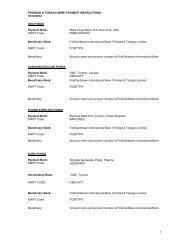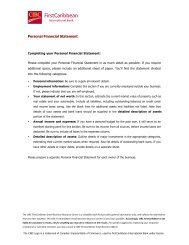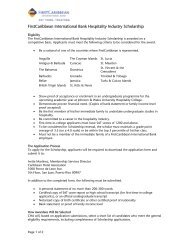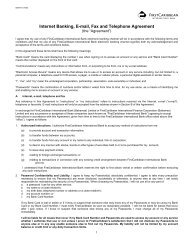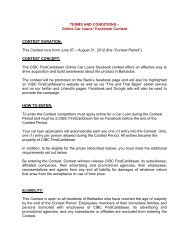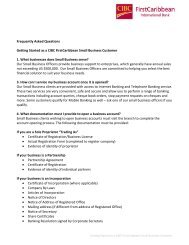FirstCaribbean International Bank (Bahamas) Limited
FirstCaribbean International Bank (Bahamas) Limited
FirstCaribbean International Bank (Bahamas) Limited
- No tags were found...
You also want an ePaper? Increase the reach of your titles
YUMPU automatically turns print PDFs into web optimized ePapers that Google loves.
Notes to Consolidated Financial StatementsFor the year ended October 31, 2009(Expressed in thousands of Bahamian dollars)2. Accounting Policies (Continued)2.4 Summary of Significant Accounting Policies (continued)(6) Impairment of financial assetsThe <strong>Bank</strong> assesses at each balance sheet date whether there is objective evidence that a financial asset or group offinancial assets is impaired. A financial asset or a group of financial assets is deemed to be impaired and impairmentlosses are incurred if, and only if, there is objective evidence of impairment as a result of one or more events thatoccurred after the initial recognition of the asset (a ‘loss event’) and that loss event (or events) has an impact on thefuture cash flows of the financial asset or group of financial assets that can be reliably estimated. Objective evidencethat a financial asset or group of financial assets is impaired includes observable data that comes to the attention ofthe <strong>Bank</strong> about the following loss events:i) significant financial difficulty of the issuer or obligor;ii) a breach of contract, such as a default or delinquency in interest or principal payments;iii) the <strong>Bank</strong> granting to a borrower, for economic or legal reasons relating to the borrower’s financial difficulty, aconcession that the lender would not otherwise consider;iv) it becoming probable that the borrower will enter bankruptcy or other financial reorganisation;v) the disappearance of an active market for that financial asset because of financial difficulties; orvi) observable data indicating that there is a measurable decrease in the estimated future cash flows from a group offinancial assets since the initial recognition of those assets, although the decrease cannot yet be identified withthe individual financial assets in the group, including:- adverse changes in the payment status of borrowers in the group; or - national or local economic conditionsthat correlate with default on the assets in the group.If there is objective evidence that an impairment loss on loans and advances to customers or held-to-maturityinvestments carried at amortized cost has been incurred, the amount of the loss is measured as the difference betweenthe carrying amount and the recoverable amount, being the estimated present value of expected cash flows, includingamounts recoverable from guarantees and collateral, discounted based on the current effective interest rate.When a loan is uncollectible, it is written off against the related provision for impairment; subsequent recoveries arecredited to the provision for impairment losses. If the amount of the impairment subsequently decreases due to anevent occurring after the write-down, the release of the provision is credited to the provision for loan loss impairmentin the consolidated statement of income.In circumstances where central bank guidelines and regulatory rules require provisions in excess of those calculatedunder IFRS, the difference is accounted for as an appropriation of retained earnings and is included in a nondistributablegeneral banking reserve.(7) Impairment of non-financial assetsThe <strong>Bank</strong> assesses at each reporting date or more frequently if events or changes in circumstances indicate that thecarrying value may be impaired, whether there is an indication that a non-financial asset may be impaired. If anysuch indication exists, or when annual impairment testing for an asset is required, the <strong>Bank</strong> makes an estimate of theasset’s recoverable amount. Where the carrying amount of an asset (or cash-generating unit) exceeds its recoverableamount, the asset (or cash-generating unit) is considered impaired and is written down to its recoverable amount.For assets, excluding goodwill, an assessment is made at each reporting date as to whether there is any indication thatpreviously recognized impairment losses may no longer exist or may have decreased. If such indication exists, therecoverable amount is estimated. A previously recognized impairment loss is reversed only if there has been a changein the estimates used to determine the asset’s recoverable amount since the last impairment loss was recognized. Ifthat is the case, the carrying amount of the asset is increased to its recoverable amount. Impairment losses relating toGoodwill cannot be reversed for subsequent increases in its recoverable amount in future periods.27



